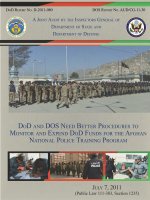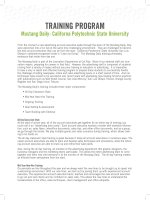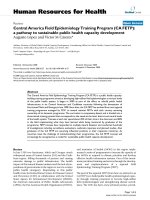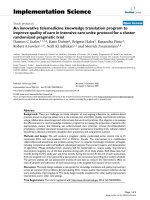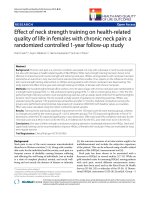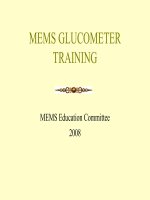Ethiopian field epidemiology training program (EFETP) compiled body of works in field epidemiology
Bạn đang xem bản rút gọn của tài liệu. Xem và tải ngay bản đầy đủ của tài liệu tại đây (4.47 MB, 258 trang )
ADDIS ABABA UNIVERSITY, COLLEGE OF HEALTH SCIENCE,
SCHOOL OF PUBLIC HEALTH
Ethiopian Field Epidemiology Training Program (EFETP)
Compiled Body of Works in Field Epidemiology
By
Daniel Tamirat Dinku (BSc)
Submitted to the School of Graduate Studies of Addis Ababa
University in Partial Fulfillment for the Degree of Master of
Public Health in Field Epidemiology
26, June, 2017
Addis Ababa
Complied BOW (dtdtamrat@ yahoo.com)
Page 1
ADDIS ABABA UNIVERSITY, COLLEGE OF HEALTH SCIENCE,
SCHOOL OF PUBLIC HEALTH
Ethiopian Field Epidemiology Training Program (EFETP)
Compiled Body of Works in Field Epidemiology
By
Daniel Tamirat Dinku
Submitted to the School of Graduate Studies of Addis Ababa
University in Partial Fulfillment for the Degree of Master of
Public Health in Field Epidemiology
Mentors
1. Pro. Fikre Enquselassie
2. Mr. Wondimu Ayele
26, June, 2017
Addis Ababa
Complied BOW (dtdtamrat@ yahoo.com)
Page 2
ADDIS ABABA UNIVERSITY SCHOOL OF GRADUATE STUDIES
Compiled Body of Works in Field Epidemiology
By
Daniel Tamirat Dinku
Ethiopian Field Epidemiology Training Program (EFETP)
School of Public Health, College of Health Sciences
Addis Ababa University
Approval by Examining Board
_________________________________
Chairman, School Graduate Committee
____________________
________________________________
Examiner
_________________________
________________________________
Advisor
__________________________
________________________________
_________________________
Examiner
Complied BOW (dtdtamrat@ yahoo.com)
Page 3
ACKNOWLEDGMENTS
There are many contributors those were directly or indirectly participated in the fruitfulness of
this document starting from individuals to institutions. First of all, I would like to thank in a very
special way my Mentor, Pro. Fikre Enquselassie , Mr. Wondimu Ayele instructor at Addis Ababa
University, who worked with me hand in hand, and vigorously, right from guidance on
investigation and assessment phase to the final and most technical phase of this document.
Second, I would like to thanks Dr. Adamu Adisie, Mr. Endashwu Shiberu , Dr. Lucy Boulanger ,
Dr.Tatek Ambesse , and Mr. Abdulnaser Abagero for their kind and constructive inputs. The
comments and suggestions you all gave me during field base stay were give brightness for this
document.
Third, I would also like to thank my colleagues, Public Health Emergency Management staffs,
and my classmates, cohort VII Field Epidemiology Training Program Residents, for their input
during my presentations for parts of this document.
Forth, I would like to thank all study participants for their patience and hospitality to provide
clinical specimens and epidemiological information for outbreak investigation part of this
document.
Fifth, my gratitude goes to SNNP regional health bureaus, zonal health departments, woreda
health offices and health facilities those were participated during investigation and assessment
for their kind assistance and guidance.
Finally, I would also extend my acknowledgement to Ethiopian Public Institute (EPHI),
Ethiopian Public Health Association (EPHA), and CDC for covering all the coasts used to
conduct all separated papers indicated in this document.
Complied BOW (dtdtamrat@ yahoo.com)
Page 4
TABLE OF CONTENT
Table of Contents
ACKNOWLEDGMENTS ........................................................................................................................... IV
TABLE OF CONTENT................................................................................................................................. II
LIST OF TABLES....................................................................................................................................... IV
LIST OF FIGURES .................................................................................................................................... VII
LIST OF MAPS ........................................................................................................................................... IX
LISTS OF PHOTOS .................................................................................................................................... IX
LIST OF ANNEX ..........................................................................................................................................X
ACRONYM AND ABBREVIATION......................................................................................................... XI
EXECUTIVE SUMMARY .......................................................................................................................XIII
CHAPTER I - OUTBREAK INVESTIGATION ...........................................................................................1
1.1 AWD OUTBREAK INVESTIGATION AT ARBAMINCH ZURIA WOREDA, GAMOGOFA ZONE SNNPR,
JUNE 2016 ................................................................................................................................................. 1
1.2 MALARIA OUTBREAK INVESTIGATION IN DASSENCH WOREDA, SOUTH OMO ZONE, SNNPR,
SEPTEMBER 2016. ................................................................................................................................... 29
CHAPTER II- MALARIA SURVEILLANCE DATA ANALYSIS REPORT............................................51
2.1 MALARIA SURVEILLANCE DATA ANALYSIS IN SOUTH OMO ZONE, SNNPR ETHIOPIA , FROM 2003 TO
2007EFY...................................................................................................................................................51
CHAPTER III-EVALUATION OF SUREVILLANCE SYSTEM ..............................................................74
3.1 EVALUATION OF SOUTH OMO ZONE MALARIA SURVEILLANCE SYSTEM November 2016 .............. 74
CHAPTER IV- HEALTH PROFILE DISCRIPTION REPORT................................................................137
4.1DASSENCH WOREDA HEALTH PROFILE ANALYSIS SOUTH OMO,SNNPR ,2016 ...............................137
CHAPTER V-SCIENTIFIC MANUSCRIPTS FOR PEER REVIEWED JOURNALS ............................164
5.1 AWD OUTBREAK INVESTIGATION IN ARBAMINCH ZURIA WOREDA, GAMOGOFA ZONE, SNNPR,
JUNE 2016 ............................................................................................................................................. 164
CHAPTER VI- ABSTRACT FOR SCIENTIFIC PRESENTATION ........................................................176
6.1 INVESTIGATION OF AWD OUTBREAK IN ARBANINCH ZURIA WOREDA, SNNP REGION,
ETHIOPIA,JUNE 2016.............................................................................................................................176
Complied BOW (dtdtamrat@ yahoo.com)
Page II
6.2 MALARIA OUTBREAK INVESTIGATION IN PASTORALIST COMMUNITY OF DASSENCH WOREDA
,SOUTH OMO ZONE ,SNNPR REGION, ETHIOPIA'S , SEPTEMBER 2016................................................177
CHAPTER VII-NARRATIVE SUMMARY OF DISASTER SITUATION VISITED.............................178
7.1 THE "BELG SEASON' HUMAN HEALTH AND NUTRITION EMERGENCY NEEDS ASSESSMENT IN
GAMOGOFA ZONE, SNNPR, JUNE 2016 ................................................................................................178
HHAPTER VIII – PROTOCOL/PROPOSAL FOR EPIDEMIOLOGIC RESEARCH PROJECT ...........202
8.1 Assessment of Prevalence and associated risk factor of Malaria in SalaMago Woreda of South Omo
Zone, SNNPR, Ethiopia, September 2017 .............................................................................................202
CHAPTER IX – TRAINING......................................................................................................................222
9.1 ACUTE WATERY DIARRHEA (AWD) OUTBREAK CONTROL ..............................................................222
CHAPTER X – PUBLIC HEALTH EMERGENCY MANAGEMENT WEEKLY BULLETIN .............231
10.1. Public Health Emergency Management Week 41 Bulletin (2016)...............................................232
10.2. Public Health Emergency Management Week 39 Bulletin (2016)...............................................236
Complied BOW (dtdtamrat@ yahoo.com)
Page III
LIST OF TABLES
Table 1Attack Rate by Kebeles Arba Minich zuria worda,GamoGofa Zone ,SNNPR. June 2016
................................................................................................................................................................................... 13
Table 2: Distribution of cases by kebele and Sex, and Sex specific attack rate ,Arba Minich
zuria worda,GamoGofa Zone ,SNNPR......................................................................................................... 13
Table 3: Demographic Characteristics of Cases and Control for AWD outbreak,Arba Minch
Zuria Woreda,Gamo Gofa Zone,SNNPR,June13/2016 to July27/2016 ......................................... 14
Table 4: Bivariate and Multiariate analysis of risk factors for AWD Outbreak Areba Minich
Zuria woreda, Gamo Gofa Zone SNNPR July 2016................................................................................. 15
Table 5:- Number and type of Water Treatment Chemical Distributed in ArebaMinch Zuria
woreda June 2016.............................................................................................................................................. 19
Table 6:- Number of inspected and newly constructed latrine in ArebaMinch Zuria woreda
June 2016 .............................................................................................................................................................. 19
Table 7:- Different Institution Inspected During AWD Outbreak In ArbaMinch Zuria Woreda
June 2016 .............................................................................................................................................................. 19
Table 8: Malaria cases and deaths by age and sex, Delerele Kebele, Dassench Wreda, South
Omo Zone, SNNPR region, Ethiopia, from 39 to 41 week 2016 ....................................................... 39
Table 9:Bivariate and Multivariate analysis of risk factors for Malaria outbreak at Delerele
kebele of Dassench woreda September 2016......................................................................................... 39
Table 10: Total IPD and Mortality of Malaria in South Omo Zone, SNNPR Region from 20032007EFY ................................................................................................................................................................ 59
Table 11: Malaria In pregnancy in South Omo Zone, SNNPR region from 2003- 2007EFY. 60
Table 12: Malaria Case Distribution in South Omo Zone, SNNPR region with list of species
of plasmodium by Woreda from 2003-2002EFY.................................................................................. 61
Table 13: Trend of prevalence Rate of malaria cases in South Omo Zone, SNNPR region
from 2003- 2007EFY ........................................................................................................................................ 62
Table 14: Malaria treated by Confirmatory test and treated with clinical sign and symptom
in South Omo Zone, SNNPR region from 2003- 2007EFY................................................................. 64
Table 15: Trend Of confirmed Malaria by woreda in South Omo Zone, SNNPR region from
2003- 2007EFY ................................................................................................................................................... 67
Complied BOW (dtdtamrat@ yahoo.com)
Page IV
Table 16: Percentage of plasmodium species in South Omo Zone, SNNPR region from 20032007EFY ................................................................................................................................................................ 68
Table 17: Percentage of plasmodium species in Woreda , South Omo Zone, SNNPR region
from 2003- 2007EFY ........................................................................................................................................ 70
Table 18: Average Percentage of Plasmodium species distribution across the woreda in
South Omo Zone, SNNPR region from 2003- 2007EFY..................................................................... 70
Table 19: Reported malaria cases through surveillance system, South Omo Zone, SNNPR,
2008EFY ................................................................................................................................................................ 88
Table 21: Population in different groups, Dassench district, SNNPR region, 2007 EFY ......142
Table 23: Professional to Population Ratio, Dassench district, SNNPR region, 2007 EFY ..143
Table 24: Top Ten Leading Causes of OPD visit, Dassench district, SNNPR region, 2007 EFY
.................................................................................................................................................................................145
Table 25: Malaria Case by Parasitic Specious Dassench Woreda, SNNPR Region, 2006 to
2008 EFY .............................................................................................................................................................146
Table 26:Number of Malaria cases in Dassench district by age category from 22/0426/05/2008EFY ...............................................................................................................................................146
Table 27: Tb/Leprosy Indicator, Dassench Woreda, SNNPR Region, 2007 EFY ....................148
Table 28: Public Health Emergency Management of Immediately and Weekly Reportable
Diseases, Dassench Woreda, SNNPR Region, 2007 EFY .................................................................149
Table 29: Budget allocation for health, DassenchWoreda, SNNPR Region, 2007 EFY. .........150
Table 30: Attack Rate by Kebeles Arba Minich zuria worda,GamoGofa Zone ,SNNPR .........170
Table 31: Bivariate analysis of risk factors for AWD Areba Minich Zuria woreda, Gamo Gofa
Zone SNNPR ,July 2016..................................................................................................................................171
Table 32: Bivariate and Multivariate analysis of associated risk factors for AWD outbreak
Areba Minich Zuria woreda, Gamo Gofa Zone SNNPR, June 2016 ................................................172
Table 33: Distribution malaria cases among the four selected woreda of GamoGofa zone
from October to May in 2007& 2008 EFY ............................................................................................182
Table 34Malnourished caseloads in four Woredas of Gamogofa zone, Oct 2015 to May 2016.
.................................................................................................................................................................................182
Table 35: Type of Risk and Population at Risk Identified at Woreda Level, June 2016 .......184
Table 36: Top five causes of morbidity by age group, 2008 EC .....................................................185
Complied BOW (dtdtamrat@ yahoo.com)
Page V
Table 37: Work plan for malaria prevalence and risk factor assessment, SalaMago
Woredaof South Omo Zone, SNNPR, 2017 .............................................................................................218
Table 38: Top 10 woredas with highest malaria case in last one month, SNNPR, week 41,2016.
.................................................................................................................................................................................233
Table 39: Top 10 woredas with highest malaria case in last one month, SNNPR, week 39,2016.
.................................................................................................................................................................................237
Complied BOW (dtdtamrat@ yahoo.com)
Page VI
LIST OF FIGURES
Figure 1: Distribution of AWD cases by date of onset, ArebaMinich Zuria Woreda
,GamoGofa Zone,SNNPR June 2016............................................................................................................. 12
Figure 2: Malaria cases by weeks in Dassench Woreda ,South Omo Zone, Sept. 2016 ........... 38
Figure 3: Distribution of malaria Cases by date of onset at Delerele Kebele,Dasseench
Woreda, south Omo Zone SNNPR September ,2016 ........................................................................... 38
Figure 4: Shows Photo of Identified risk factor in malaria affected kebeles of Dasseench
woreda September 2016................................................................................................................................. 40
Figure 5: Shows Photo of different interventions (Case Treatment & Environmental
Management) in Iceland’s of Delerele kebele, Dassench woreda September 2016................. 41
Figure 6: Shows photo of ITNs distribution, Data collection & Social Mobilization in Malaria
affected area of Delerele kebele, Dassench Woreda............................................................................. 42
Figure 7: Malaria trend in South Omo Zone, SNNPR Region (from 2003-2007EFY) in
February 2016..................................................................................................................................................... 59
Figure 8: IPD and Death rates of Malaria Cases in South Omo Zone, SNNPR ( from 20032007EFY) in February 2016 .......................................................................................................................... 60
Figure 9: The total Malaria prevalence and confirmed Rate in the South Omo Zone, SNNPR
region (from 2003- 2007EFY) in February 2016 .................................................................................. 63
Figure 10: Malaria slide positivity rate of South Omo Zone, SNNPR region (from 20032007EFY) in February 2016 .......................................................................................................................... 63
Figure 11: Trend of Confirmed malaria cases in South Omo Zone, SNNPR region (from
2003- 2007EFY) inFebruary 2016 .............................................................................................................. 65
Figure 12 : Trend of Confirmed malaria cases and Expect threshold in South Omo Zone,
SNNPR region (from 2003- 2007EFY) in February 2016 .................................................................. 66
Figure 13: Percentage of malaria cases treated typically by Sign and symptoms and By
Laboratory Investigation in South Omo Zone, SNNPR region (from 2003- 2007EFY) in
February 2016..................................................................................................................................................... 66
Figure 14: Average number Of Malaria Cases reported per year in Wordas of South Omo
Zone, SNNPR (from 2003- 2007EFY) in February 2016..................................................................... 68
Complied BOW (dtdtamrat@ yahoo.com)
Page VII
Figure 15: Average number of malaria cases per year per 1000 average population in
different woreda of south omo zone (From 2003 to 2007 EFY) in February 2016 ................. 68
Figure 16: Average Percentage of Plasmodium distribution in South Omo Zone, SNNPR
region (from 2003- 2007EFY) in February 2016 .................................................................................. 69
Figure 17: Illustrating The Formal And Informal Flow Of Surveillance Data And Information
Through Out Health System........................................................................................................................... 78
Figure 18: Malaria Monitoring Chart By Month’s At Dassench Woreda South Omo Zone
SNNPR, (in 2008 EFY) November 2016 .................................................................................................... 82
Figure 19: Malaria Monitoring Chart by Month at South Ari Woreda South Omo Zone
SNNPR, (in 2008 EFY) November 2016 .................................................................................................... 83
Figure 20: Malaria Monitoring Chart By Monthh At Bena Tsemay Woreda South Omo Zone
SNNPR, (in 2008 EFY) November 2016 .................................................................................................... 84
Figure 21: Malaria Monitoring Chart by Monthh at Jinka Town Administration, South Omo
Zone SNNPR, (in 2008 EFY) November 2016 ......................................................................................... 85
Figure 22: Malaria prevalence by Month and Woreda at Dassench, South Ari, BenaTsemay
and Jinka Town Administration , South Omo Zone , SNNPR, (in 2008 EFY) November 2016
................................................................................................................................................................................... 86
Figure 23: Population distribution by sex, Dassench district, SNNPR region, 2007 EFY.....141
Figure 24: Distribution of cholera cases by date onset, ArebaMinich Zuria Woreda
,GamoGofa Zone,SNNPR ................................................................................................................................170
Figure 25: SAM Case Load in Kamba Woreda, October 2015 to May 2016...............................187
Figure 26: SAM Case Laod in UbaDebretsehayWoredaWoreda, Octo 2015 to May 2016 ...188
Figure 27: SAM Case Laod in ZalaWoreda, Octo 2015 to May 2016 ............................................189
Figure 28: Conceptual Framework of Sampling technique, SalaMago Woreda, South Omo
Zone, SNNPR, 2017..........................................................................................................................................215
Complied BOW (dtdtamrat@ yahoo.com)
Page VIII
LIST OF MAPS
MAP 1: Map of Areba Minchi Zuria Woreda with those kebeles affected by AWD and
marked with red dot June 2016 ...................................................................................................................... 8
MAP 2: Map of Dassench Woreda and those kebele Affected by Malaria (Delerele kebele
shaded with red .................................................................................................................................................. 34
MAP 3: Map of Ethiopia SNNPR and Location of South Omo Zone ................................................. 56
MAP 4: Area Map of Selected Woredas for Malaria Surveillance Evaluation, South Omo
Zone, SNNPR, November 2016 ..................................................................................................................... 80
MAP 5: Map of Dasenech district showing location that indicates at which health Profile
analysis conducted ..........................................................................................................................................139
MAP 6: Map of SalaMago Worreda ............................................................................................................213
LISTS OF PHOTOS
Photo 1:- Photo shows Social Mobilization Activities Concerning AWD in ArebaMinch Zuria
woreda June 2016.............................................................................................................................................. 17
Photo 2:- Photo Shows When AWD Cases are treated at CTC Center in ArebaMinch Zuria
woreda June 2016.............................................................................................................................................. 17
Photo 3:- Photo Shows Distribution and Demonstration of Water Treatment Chemical ...... 18
Photo 4:- Shows Sanitation Campaign & Disinfection of Contaminated Place in ArebaMinch
Zuria woreda June 2016.................................................................................................................................. 18
Photo 5:- Photo shows coordination team conducting daily review meeting during AWD
Outbreak period in ArebaMinch Zuria Woreda June 2016................................................................ 20
Complied BOW (dtdtamrat@ yahoo.com)
Page IX
LIST OF ANNEX
Annex 1: GamoGofa Zone Cholera Outbreak Investigation Questionnaire ................................ 24
Annex 2: Dassench Woreda Malaria Outbreak investigation Questionnaire.............................. 46
Annex 3: Surveillance System Evaluation Check List.........................................................................100
Annex 4: Health Profile data collection Tool (Checklist).................................................................154
Annex 5: Health and Nutrition Emergency Needs Assessment Check List................................193
Annex 6: Budget breakdown for malaria prevalence and risk factor assessment, SalaMago
Woreda, South Omo Zone, SNNPR, 2017 ................................................................................................218
Annex 7: Main points that include in the Training of Acute Watery diarrheal diseases
Management.......................................................................................................................................................226
Complied BOW (dtdtamrat@ yahoo.com)
Page X
ACRONYM AND ABBREVIATION
AAU-SPH
Addis Ababa University School Of Public Health
ANC
Antenatal Care
AIDS
ART
AWD
CBN
CBR
CDR
CDTI
CI
CMR
CTC
EFETP
EFY
ENHS
EOS
EPHA
EPI
FMOH
GR
HDA
HEW
HIV
IDSR
IMR
IPD
IRS
LLITN
MCH
Acquired Immune-Deficiency Syndrome
Anti-Retroviral Treatment
Acute Watery Diarrhea
Community Based Nutrition
Crude Birth Rate
Crude Death Rate
Community Directed Treatment With Ivermectin
Confidence Interval
Child Mortality Rate
Cholera Treatment Center
Ethiopian Field Epidemiology Training Program
Ethiopian Fiscal Year
Environmental Health Science
Enhanced Outreach Strategy
Ethiopian Public Health Association
Extended Program On Immunization
Federal Ministry Of Health
Growth Rate
Health Development Army
Health Extension Worker
Human Immuno-Deficiency Virus
Integrated Disease Surveillance And Response
Infant Mortality Rate
In Patient Department
Insecticide Residual Spray
Long Lasting Insecticide Treated Net
Maternal And Child Health
Complied BOW (dtdtamrat@ yahoo.com)
Page XI
MMR
Maternal Mortality Rate
OPD
Out Patient Department
NMR
OPD
OPV
OR
OTP
P
P.F
P.v
PHEM
PICT
PLWHIV
PMTCT
PNC
PTB
RDT
RDT
RHB
Rx
SNNPR
TB
TBA
TFU
TSF
TT
UNICEF
VCT
WHO
Wk
Neonatal Mortality Rate
Outpatient Department
Oral Polio Vaccine
Odds Ratio
Outpatient Therapeutic Program
P-Value
Plasmodium Falciparium
Plasmodium Vaivax
Public Health Emergency And Management
Provided Initiated Counseling And Testing
Peoples Living With HIV/AIDS
Prevention Mother To Child Transmission
Postnatal Care
Pulmonary Tuberculosis
Rapid Diagnostics Test
Rapid Diagnostic Test
Regional Health Bureau
Treatment
South Nation Nationalities Peoples Region
Tuberculosis
Traditional Birth Attendant
Therapeutic Feeding Unit
Therapeutic Supplementary Feeding
Tetanus Toxoid
United Nation Children Fund
Voluntary Counseling And Testing
World Health Organization
Week
Complied BOW (dtdtamrat@ yahoo.com)
Page XII
EXECUTIVE SUMMARY
This document contains a two years Field Epidemiology Training Program outputs which is
equivalent with thesis to be submitted to graduate school of public health for partial fulfillment
of master degree in Field Epidemiology. It includes reports of diseases outbreak investigations,
public health surveillance data analysis, surveillance system evaluation, narrative summary of
disaster situation report, manuscripts, abstracts, and training reports.
Accordingly the document is organized to ten chapters; chapter one contains diseases outbreak
investigations. I conducted two outbreak investigations as first Author and the investigations
were conducted using case control study design. Investigation report contains abstract,
introduction, methods, discussions, conclusion, recommendations, acknowledgement and
references separately.
Chapter two contains report of Malaria surveillance data analysis in south omo zone health
department. In data analysis five years data were used. Type of malaria species in the zone was
clearly identified; trends and seasonality of malaria were also determined. And also the incidence
rate and population at risk for malaria were identified.
Chapter three addresses surveillance system evaluation entitled “An Evaluation of Malaria
Surveillance System in South Omo Zone”. This chapter clearly presents the purpose and
objectives of the surveillance and its progress towards its objectives. The surveillance attributes:
simplicity, flexibility, stability, acceptability, representativeness, timeliness, data quality, and
sensitivity were also assessed in the chapter.
Chapter four contains assessment of Dassench Woreda health profile. In the chapter health and
health related data of the woreda populations were evidently presented which is very imperative
for prioritizing high-flying problems. It is basic for planning and undertaking appropriate public
health interventions; and is doorway point for operational public health researches. Stake holders
of health and health related issues will access evidence based information from this chapter.
Chapter five contains Scientific Manuscripts for Peer reviewed Journals. In his chapter one
manuscript were presented. The manuscripts were prepared according to Ethiopian journal of
health development author’s guideline.
In chapter six abstracts of outbreak investigations. The abstract entitled “Investigation of AWD
outbreak in Ethiopia's SNNPR Region and Investigation of Malaria outbreak in pastoralist
Complied BOW (dtdtamrat@ yahoo.com)
Page XIII
community of Dassench woreda ,South Omo Zone ,SNNPR Region, in Ethiopia's , September
2016 ”.
Chapter seven includes the narrative disaster situation report. As part of early warning and
vulnerability assessment the government of Ethiopia has been conducting nationwide human
health and nutrition emergency need assessment twice a year in collaboration with different
government sectors and partners. The assessment was conducted to identify potential problems
which need humanitarian assistance. Based on the report from the assessment humanitarian
requirement document was developed and shared with potential partners for response. This
chapter clearly presents Belg season human health and nutrition need assessment conducted in
GamoGofa Zone of SNNP Region.
One protocols or proposals for epidemiological projects were damped in chapter eight. The
proposal entitled “Assessment of Prevalence and associated risk factor of Malaria in SalaMago
Woreda of South Omo Zone , South Nation Nationalities peoples Regional State” was developed
for epidemiological project to be submitted to Addis Ababa University School of Public Health.
Chapter nine describes training conducted on AWD outbreak control. The training addressed
overview and epidemiology of AWD/Cholera,
Set up and Organization of AWD Cases
treatment Centre, About AWD Cases management Protocol, Who is most at risk?, General
hygiene in CTCs, Sanitation and Hygiene precautions during Closure of CTCs, practical
demonstration on stool specimen collection testing with RDT, house hold level water treatment
procedure and Infection prevention during AWD/Cholera outbreak.
Finally, Public Health Emergency weekly bulletins were indicated in chapter ten. Of many
weekly bulletins I was prepared during the two years field base attachment, I was includes only
two of them in this document. The weekly bulletins were communicated to different stakeholders
including ministry of health through Deputy Director General of Ethiopian Public Health
Institute on weekly bases.
Complied BOW (dtdtamrat@ yahoo.com)
Page XIV
CHAPTER I - OUTBREAK INVESTIGATION
1.1 AWD OUTBREAK INVESTIGATION AT ARBAMINCH ZURIA WOREDA,
GAMOGOFA ZONE SNNPR, JUNE 2016
Daniel T. Dinku1, 2 , E. Fikre3 , A. Wondimu3 , A. Adamu3 , A. Abdulnaser4 , G. Markos1,2
1Ethiopian Field Epidemiology Training Program Resident, 2PHEM officer, 3 Instructor at
Addis Ababa University, 4Resident advisor at Addis Ababa University
Abstract
Introduction: Populations living in rural kebeles with inadequate water and sanitation
infrastructure are at risk of epidemic disease. Acute Watery Diarrhea is one of a diarrheal disease
caused by infection of the intestine with the bacterium Vibrio cholera, either type O1 or O139.
Suspected Acute Watery Diarrheal disease (AWD) was reported from Areba Minch Zuria
Woreda Health Office, GamoGofa Zone, SNNPR, Ethiopia on June 13 /2016. On June 17/2016
the regional health bureau deployed a team organized from WHO, UNICIEF and Public health
emergency management to conduct the investigation and to describe the magnitude of the
outbreak, identify risk factors, and implement control measures.
Methods: Descriptive followed by unmatched Case control (1:2) study was conducted on Areba
Minch Zuria Woreda Health Office, GamoGofa Zone from June 21 to 30 /2016 and our samples
are all eligible cases during study period. 50 active cases (40% of the total cases from the CTC
center) and 100 controls (that are neighbor to the cases) were selected. We defined suspected
cases and controls according to WHO guide line and the data were collected by principal and co
investigator in face-to-face interviews of cases in CTC Center and house to house based on line
list and controls were nearby living houses of the cases. Questionnaire included sociodemographics, knowledge and risk factors for AWD transmissions and a pre-test will be
Complied BOW (dtdtamrat@ yahoo.com)
Page 1
employed in ten household that nearest to the CTC center. The data were first cleaned then
entered and analyzed by epi-info version 7.2. Analytical and descriptive analysis was done and
the results were presented by epi curve, graphs, tables and map.
Results: A total of 125 cases were reported from June 13/2016 to July 27/2016. From the total
cases 89(71%) were male and 36(29%) were female. The mean age of cases was 24 with
standard deviation of ±12 respectively. Five Kebeles (Shelemela, Elego, Kolashele, Gentasira
and Wozeqa) were affected by the outbreak. Among the affected Kebeles Shelemela reported
40(32%) cases from the total reported cases. The overall attack rate was 5 per 1000 population.
The sex specific attack rate was 7 for male and 3 for females per 1000 population; the highest
AR was in Elego Kebele which is 7 per 1000 population. On multivariate analysis factors that
statistically significant association with AWD outbreak were Drinking of lake water (OR: 6.7;
95%CI: 1.2 – 23.7 ; P:< 0.04) , Drinking of Cheka (Local drink) (OR: 5.6; 95%CI: 2.4 – 13.2 ;
P:< 0.001) ,Using river water for washing utensils (OR: 4.1; 95%CI: 1.2-13.4; P: < 0.02). Water
specimen from Lake Chamo and Sego River showed fecal contamination. 30 stool specimen was
collected for laboratory investigation (2 positive for culture, 21 positive for RDT & 7 are
Negative) and Vibrio cholera sera group 01, sera type ogawa identified.
Conclusion: In the woreda attack rate of AWD related to insufficient access to safe water
therefore future epidemics will undoubtedly occur unless the Zonal and Woreda government
should properly addressed the basic water and sanitation deficiencies in the community. Also
woreda water office should provide continuously water treatment chemical to the community
especially who living along the sides of Lake Chamo and Sego River.
Complied BOW (dtdtamrat@ yahoo.com)
Page 2
INTRODUCTION
Cholera is a diarrheal disease caused by infection of the intestine with the bacterium Vibrio
cholera, either type O1 or O139. Both children and adults can be infected. About 20% of those
who are infected develop acute, watery diarrhea – 10–20% of these individuals develop severe
watery diarrhea with vomiting. If these patients are not promptly and adequately treated, the loss
of such large amounts of fluid and salts can lead to severe dehydration and death within hours.
The case-fatality rate in untreated cases may reach 30–50%. Treatment is straightforward
(basically rehydration) and, if applied appropriately, should keep case-fatality rate below 1%.
Cholera is usually transmitted through faecally contaminated water or food and remains an everpresent risk in many countries. New outbreaks can occur sporadically in any part of the world
where water supply, sanitation, food safety, and hygiene are inadequate. The greatest risk occurs
in over-populated communities and refugee settings characterized by poor sanitation, unsafe
drinking-water, and increased person-to person transmission. Because the incubation period is
very short (2 hours to 5 days), the number of cases can rise extremely [1].
EPIDEMIOLOGY
Cholera is vastly underreported, and precise measurements of the morbidity and mortality
attributable to V. cholerae infection are lacking. However, there are an estimated 3 million cases
of diarrheal illness and approximately 100,000 deaths worldwide caused by V. cholera
annually [2].
Cholera is an acute enteric infection caused by the ingestion of bacterium Vibrio cholerae present
in faecally contaminated water or food. Primarily linked to insufficient access to safe water and
proper sanitation, its impact can be even more dramatic in areas where basic environmental
infrastructures are disrupted or have been destroyed. Countries facing complex emergencies are
particularly vulnerable to cholera outbreaks. Massive displacement of people or refugees to
overcrowded settings, where the provision of potable water and sanitation is challenging,
constitutes also a risk factor. In consequence, it is of paramount importance to be Cholera is
vastly underreported, and precise measurements of the morbidity and mortality attributable to V.
cholerae infection are lacking. However, there are an estimated 3 million cases of diarrheal
illness and approximately 100,000 deaths worldwide caused by V. cholera annually [2].
Complied BOW (dtdtamrat@ yahoo.com)
Page 3
Cholera is an acute enteric infection caused by the ingestion of bacterium Vibrio cholerae
present in faecally contaminated water or food. Primarily linked to insufficient access to safe
water and proper sanitation, its impact can be even more dramatic in areas where basic
environmental infrastructures are disrupted or have been destroyed. Countries facing complex
emergencies are particularly vulnerable to cholera outbreaks. Massive displacement of people
or refugees to overcrowded settings, where the provision of potable water and sanitation is
challenging, constitutes also a risk factor. In consequence, it is of paramount importance to be
able to rely on accurate surveillance data to monitor the evolution of the outbreak and to put
in place adequate intervention measures Coordination of the different sectors involved is
essential, and WHO calls for the cooperation of all to limit the effect of cholera on
populations [2, 3].
Cholera is characterized in its most severe form by a sudden onset of acute watery diarrhea
that can lead to death by severe dehydration. The extremely short incubation period - two
hours to five days - enhances the potentially explosive pattern of outbreaks, as the number of
cases can rise very quickly. About 75% of people infected with cholera do not develop any
symptoms. However, the pathogens stay in their faeces for 7 to 14 days and are shed back into
the environment, possibly infecting other individuals. Cholera is an extremely virulent disease
that affects both children and adults. Unlike other diarrheal diseases, it can kill healthy adults
within hours. Individuals with lower immunity, such as malnourished children or people
living with HIV, are at greater risk of death if infected by cholera [3].
Cholera affects an estimated 3 million people worldwide, and causes 58,000–130,000 deaths a
year as of 2010. This occurs mainly in the developing world. In the early 1980s, death rates are
believed to have been greater than 3 million a year. It is difficult to calculate exact numbers of
cases, as many go unreported due to concerns that an outbreak may have a negative impact on
the tourism of a country. Cholera remains both epidemic and endemic in many areas of the world
[4, 5].
Although much is known about the mechanisms behind the spread of cholera, this has not led to
a full understanding of what makes cholera outbreaks happen in some places and not others.
Lack of treatment of human feces and lack of treatment of drinking water greatly facilitate its
spread, but bodies of water can serve as a reservoir, and seafood shipped long distances can
Complied BOW (dtdtamrat@ yahoo.com)
Page 4
spread the disease. Cholera was not known in the Americas for most of the 20th century, but it
reappeared towards the end of that century [6].
Cholera continues to be an important public health problem among poorer communities,
particularly in Africa which accounts for more than 90% of the annual cholera cases notified to
the WHO .The modern history of the disease began in 1817 with the onset of the first (1817–
1823) of 7 distinct pandemics which have occurred so far. The sixth and, presumably ,the fifth
were caused by Vibrio cholera O1 of the classical biotype. The seventh originated on the island
of Sulawesi in Indonesiain1961,and the causative agent was V. cholera O1 of the El Tor
biotype(Kaper etal., 1995). This seventh cholera pandemic reached the African continent in1970
where there were at least 2 independent introductions of the infection (Lan and Reeves, 2002):
the first one caused outbreaks in the west (Guinea, Sierra Leone, Liberia, Nigeria, and other
coastal countries) and the spread of the disease in to the interior of the sub-Saharan states .The
second route is thought to have originated in the Middle East entering Africa from the eastern
countries of Djibouti, Ethiopia, and Somalia. Since 1970, parts of Ethiopia have been frequently
affected by cholera, acting as sources of infection for the dissemination of the 1985–1986 largescale epidemics in the Horn of Africa (Maimone et al., 1986; Coppo et al., 1995). From 1993 to
1999, they were again systematically involved as active focuses in the recurrent spreading of the
disease in the region [7].
Complied BOW (dtdtamrat@ yahoo.com)
Page 5
OBJECTIVE
General Objective
To describe the magnitude of cases and identify the risk factors associated with AWD Outbreak
and to implement control measure in Areba Minch ZuriaWoreda,GamoGofa Zone, SNNPR
Ethiopia June 2016.
Specific Objective
To identify the etiologic agent responsible for the outbreak.
To describe the magnitude of AWD Outbreak in Areba Minch ZuriaWoreda by
place
person and time
To identify the associated risk factors of the disease and to implement control measure
Complied BOW (dtdtamrat@ yahoo.com)
Page 6
METHODS AND MATERIALS
Study Area
GamoGofa zone is one of the largest zones in Southern Nations Nationalities and Peoples
Region. Its capital Areba Minch is located 270Km to the south of Hawassa. The zone borders
South Omo & Segen Area People Zone to the south, Basketo and Konta to the west,Dawuro and
Wolayta to the North ,and Oromiya and Segen Area People to the East. The Zone has a
population of 1,992,955 and administered with 15 Districts, 2 Town administrations, 452 rural
and 34 urban kebeles. In the Zone there are 2 District and 1 general hospital, 73 health centers,
and 471 health posts.
Areba Minch ZuriaWoreda is one of the administrative woreda of GamoGofa Zone. The Woreda
borders Derashe and Amaro woreda to the South,Bonke woreda to the Weast. Dita,Chencha and
Mirab Abaya Woreda to the North and AmaroWoreda and Oromiya Region to the East.Arba
Minch Woreda has a population 202,489 and administrated with 35 rural kebeles . In the woreda
there are 7 Health center and 33 health posts. The woreda latrine and water supply coverage were
90% and 85% respectively.
Complied BOW (dtdtamrat@ yahoo.com)
Page 7
Gurage
Selti
Yem
Melekoza
Hadiya
Sheka
Boreda
Kucha
Denibu Gofa
Alaba
KT
Hadiya
Keffa
Konta
Dawro
Geze Gofa
Wolayita
Zala
Mirab Abaya
Daramalo Dita
Sidama
Chencha
Ayida
Bench Maji
Basketo Gamo Gofa
Gedio
Ubadebretsehay
Kemba
Arba Minch Zuria
South Omo
Segen Peoples'
Bonke
Ü
Spot Map of AWD Cases in Gamo Gofa Zone,June 2016
Legend
Arba Minch Zuria Woreda
0 12.5 25
50 Kilometers
1 Dot = 2
AWD_Cases
MAP 1: Map of Areba Minchi Zuria Woreda with those kebeles affected by AWD
and marked with red dot June 2016
Complied BOW (dtdtamrat@ yahoo.com)
Page 8



